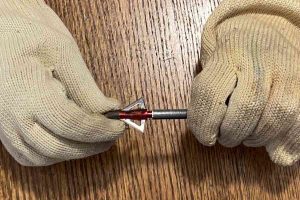For those new to archery, many of the numbers and specifications pertaining to a bow can be quite confusing.
This is understandable, as it is not always clear what these numbers represent, and many questions often arise. One such question that is often asked is, what is IBO speed?
IBO speeds are the speed at which an arrow with a weight of 5 grains per pound of draw weight is fired from a given bow.
There is no specified draw length included in IBO testing, and while the bulk of manufacturers conducts testing at 70 pounds of draw weight, weights of up to 80 pounds can be used as long as arrow weight is adjusted accordingly.
Contents (Jump to Topic)
What’s Your Bow’s Real Speed
It is of immense value to understand what arrow speed ratings associated with a particular bow are telling you, as the consumer. IBO Speeds can often be misleading if you are not aware of what exactly it is that they refer to.
Point Blank Speed
When a FPS (Feet Per-Second) rating is given regarding a particular bow, this speed is gauged at point-blank range.
This is dictated by the measurement that is received by a chronograph positioned directly in front of an archer’s arrow.
As the arrow is released, this chronograph reads and displays the detected arrow speed in a FPS measurement.
It is of value to understand that these speeds fall drastically as an arrow travels further downrange.
Therefore, such a figure is seldom accurate in predicting downrange performance, as several factors play upon arrow velocity with every successive foot that is traveled.
Which Factors Impact Arrow Speed?
Several factors directly affect the speed at which an arrow travels. Because these factors vary from one archer’s setup to the next, the only true gauge of your bow’s real arrow speed is taken with the assistance of a chronograph as it relates to your bow.
Draw Weight
A bow’s draw weight heavily influences the speed at which an arrow is propelled downrange. The higher the draw weight of a particular bow, the greater the kinetic energy imparted upon the arrow becomes.
Read more about what draw weight is right for you here
This, in turn, yields faster arrow speeds. In fact, for every 10-pound increase in draw weight, arrow speed increases an average of 20 FPS.
Draw Length
The length at which your draw length is set also is reflected heavily by your arrow’s speed. The longer your draw length is, the longer an arrow remains in contact with the bowstring during the shot cycle, and the more kinetic energy is transferred to your arrow upon release. This means that an individual who shoots a longer draw length will naturally observe higher arrow speeds. To accurately compare bow speeds, you do need a constant draw length.
As a general rule, for every additional inch of draw length, a gain of approximately 10-15 FPS of arrow speed is to be expected.
Arrow Weight
As arrow weights fluctuate from one application to the next, so do arrow speeds. A larger projectile naturally flies at a slower speed than that of a smaller size (such as a light arrow).
For every additional 5 grains of arrow weight, arrow speed is reduced by an average value of 2 FPS—heavier arrows = less speed.
Although this does not seem like much of a fluctuation in speed, arrow weights can vary as much as 100 grains or more between applications. This can lead to sizable changes in arrow velocity.
String Mounted Accessories
It is of value to understand that the bulk of bow manufacturers’ speed ratings is measured from a bow that is absent of all accessories.
When a bow is purchased, it is set up for its owner with string-mounted items such as a D-loop, peep sight, and sting silencers. Adding these accessories alone can lead to a reduction in arrow speed of up to 10 FPS.
What Is IBO Speed?
In the years since the advent of the compound bow, manufacturers have strived to outdo one another in the arena of speed. This race toward ever-increasing arrow velocity made many questions the validity of manufacturers’ claims about their bows’ arrow speeds.
Because of this, the idea of a governing body or standard metric to guide manufacturer speed testing grew in popularity. This intuition led to the birth of multiple standards from which arrow speeds were to be measured. One of those is the IBO speed testing standard.
Who Invented IBO Speed Specifications?
The International Bowhunting Organization invented the IBO speed specification. This organization has long advocated for bowhunting education, safety, and recruitment.
The International Bowhunting Organization’s motto is, “To Promote, Encourage, and Foster the Sport of Bowhunting.”
What Does It Stand For?
IBO Speed specifications are intended to standardize the method that is used to determine bow speeds across the industry. This assists in preventing false and inflated claims of a bow’s speed that might confuse consumers.
What Is ATA Speed?
ATA Speed is yet another standard for determining and recording speeds of bows across a wide range of manufacturers. This unit of testing assists in adequately describing a bow’s capability to consumers.
This standard is based upon the criteria of a bow featuring a 70-pound draw weight (+/-.2), with a 30-inch draw length, shooting a 350-grain arrow. This standard is the formal specification cited by both Hoyt and Darton archery in marketing all of their bows.
Who Invented ATA Speed Specifications?
ATA stands for Archery Trade Association. The Archery Trade Association is an organization that aims to strengthen further all aspects of archery as a whole, as well as the manufacturing, supply, and distribution chains from which modern industry practices are derived.
What Does It Stand For?
The ATA specification was established to further standardize bow speed designations on an industry-wide scale. Because this metric relies heavily upon a set draw weight, draw length, and arrow weight, ratings of this tend to be a more reliable representation of actual bow speeds based upon the criteria set forth.
Which Metric Is Best For Buying A Bow?
While IBO Speed is still commonly used by manufacturers to specify the speeds of their bows, the ATA standard tends to carry more weight in an apple-to-apple style comparison.
Since IBO testing features several variables regarding draw length and maximum draw weight, many such ratings far exceed the speeds that are viable of a fully outfitted bow under normal circumstances.
On the contrary, ATA testing relies solely upon the criteria for testing purposes. This eliminates any opportunity for manufacturers to inflate their values, thus misrepresenting their products artificially.
How Does This Correlate To Success In The Field?
When attempting to decipher if a chosen bow/arrow combination is adequate for hunting a particular game species, one must consider the amount of kinetic energy delivered downrange.
Kinetic energy is the value of force that is imparted upon your target with the delivery of an arrow and directly dictates the amount of penetration that can be expected.
The following formula can be used to figure the kinetic energy of an arrow fired from an individual’s specific bow/arrow combination:
Fps² x Weight of Arrow/450,240 =Arrow’s Kinetic Energy
For more information on finding the kinetic energy of an arrow, watch this video.
- Big Game– Most of today’s compound bows are more than adequate for taking big game species. If a moderate draw weight and length are utilized, you should have no problem obtaining the minimum kinetic energy needed for a clean kill (45 ft-lbs or greater).
If in doubt, use the formula mentioned above to assess the kinetic energy your bow/arrow combination produces.
- Small Game– Virtually any bow is well suited to taking small game. Very little arrow speed or kinetic energy is required to achieve ample penetration for a clean, quick, and ethical kill.
IBO Speed And The Role It Plays
With abundant compound bows on the market today, it can often be difficult to grasp how best to compare one offering to the next.
IBO Speed is one of the many figures used to compare compound bow performance.
Care should be taken, however, as these numbers cannot always be compared in an apples-to-apples fashion. IBO Speed is just one piece of the puzzle that warrants adequate attention when selecting the bow that best suits your needs.
Never assume that you can easily achieve the fps speeds advertised by the manufacturer. Too much depends on your individual arrow weight, draw length and draw weight.
Please feel free to comment, as we always appreciate feedback from our readers.
FAQ
Which Factors Impact Arrow Speed?
Several factors have a direct bearing on the speed at which an arrow travels. Because these factors vary from one archer’s set up to the next, the only true gauge of your bow’s real arrow speed is taken with the assistance of a chronograph as it relates to your bow.
What Is IBO Speed?
In the years since the advent of the compound bow, manufacturers have strived to outdo one another in the arena of speed. This race toward ever-increasing arrow velocity led many to begin questioning the validity of manufacturers’ claims toward their bows’ arrow speeds.
Who Invented IBO Speed Specifications?
The IBO speed specification was invented by the International Bowhunting Organization. This organization has long been an advocate for bowhunting education, safety, and recruitment.
The International Bowhunting Organization’s motto is, “To Promote, Encourage, and Foster the Sport of Bowhunting.”
What Is ATA Speed?
ATA Speed is yet another standard for determining and recording speeds of bows across a wide range of manufacturers. This unit of testing assists in adequately describing a bow’s capability to consumers.
This standard is based upon the criteria of a bow featuring a 70-pound draw weight (+/-.2), with a 30” draw length, shooting a 350-grain arrow.
Who Invented ATA Speed Specifications?
ATA stands for Archery Trade Association. The Archery Trade Association is an organization that aims to further strengthen all aspects of archery as a whole, as well as the manufacturing, supply, and distribution chains from which modern industry practices are derived.
Which Metric Is Best For Buying A Bow – IBO or ATA?
While IBO Speed is still commonly used by manufacturers to specify the speeds of their bows, the ATA standard tends to carry more weight in an apple-to-apple style comparison.
Since IBO testing features several variables in regards to draw length and maximum draw weight, many such ratings far exceed the speeds that are viable of a fully outfitted bow under normal circumstances.






